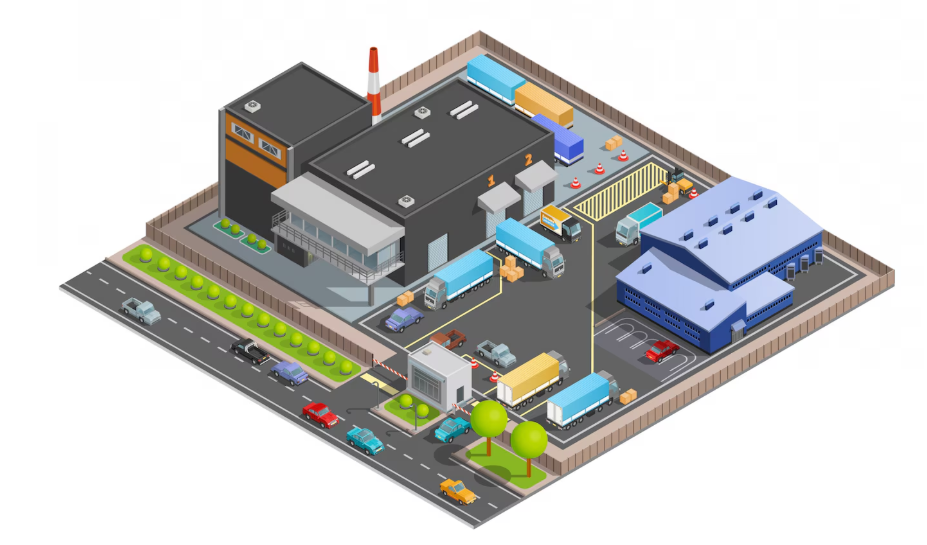Introduction: Why Floor and Pathway Design in Factories is More Than Just Concrete and Steel
When you think of factory safety, you might immediately picture hard hats, safety goggles, or fire extinguishers. But here’s something often overlooked — the very ground you’re walking on.
Yes, we’re talking about floors, platforms, catwalks, railways, roadways, and footpaths in industrial settings.
Designing these elements isn’t just about structure and load-bearing — it’s about ensuring worker safety, preventing downtime due to accidents, and creating an efficient workflow. In this detailed post, we’ll walk through the key safety factors and design aspects you need to know, whether you’re designing a new factory or upgrading an existing one.
1. The Foundation of Safety: Factory Floors
a. Load-Bearing Capacity
Factory floors must support not only static loads like heavy machinery but also dynamic loads — think forklifts, vibrating equipment, or material carts.
- Design Tip: Minimum compressive strength of 25 MPa (megapascals) for standard factory use.
- Use reinforced concrete for high-load areas.
b. Anti-Slip Surfaces
Slippery surfaces are a major cause of workplace injuries. Water, oil, or powder spills can turn any floor into a hazard.
- Design Tip: Use abrasive coatings or anti-slip epoxy layers.
- Incorporate grooved or textured patterns in flooring tiles.
c. Drainage and Slope
An often-ignored aspect is proper floor drainage. Water pooling can cause corrosion, microbial growth, and safety hazards.
- Design Tip: Slope the floor at 1:100 to 1:80 gradient toward drains.
- Use covered grated drains to prevent tripping.
2. Platforms & Catwalks: Elevated Safety Matters
a. Structural Integrity
Platforms and catwalks are elevated and thus come with higher risks. The structure must be engineered to support 3-4 times the expected load as per IS 800 and OSHA norms.
- Use MS grating or chequered plate flooring.
- Ensure minimum live load capacity of 500 kg/m².
b. Guardrails and Toe Boards
A fall from an elevated surface can be fatal. That’s why guardrails and toe boards are non-negotiable.
- Guardrail height: 1.1 meters (as per OSHA and IS 4912).
- Toe board height: Minimum 10 cm to prevent tools or materials from falling.
c. Access Ladders and Stairs
- Stairs should not be steeper than 35°.
- Tread depth: Min 250 mm; Riser height: Max 180 mm.
- Add non-slip nosing strips for additional safety.
3. Designing Internal Roads and Rail Tracks in Industrial Zones
a. Factory Roads for Vehicles
Internal roads must safely accommodate two-way vehicular movement, pedestrian crossings, and emergency vehicle access.
Design Considerations:
- Width: At least 7.5 m for two-way traffic.
- Turning radius: 9–12 m for trucks and trailers.
- Surface: Concrete or high-strength bituminous material.
Speed Bumps and Traffic Signage are essential to reduce accidents in congested areas.
b. Railway Sidings and Tracks
Factories using bulk materials (like cement, coal, or iron) often integrate railway sidings.
Key Safety & Design Elements:
- Track Slope: Avoid steep gradients; max 1 in 400.
- Buffers: Spring-loaded or hydraulic stops at dead-ends.
- Provide proper lighting and audible alarms for train movements.
4. Footpaths, Crosswalks & Pedestrian Zones
a. Dedicated Footpaths
Segregating pedestrian movement from vehicular zones is crucial.
- Width: At least 1.2 meters.
- Surface: Anti-slip pavers or concrete with tactile tiles for visually impaired.
Painted zebra crossings and footpath bollards prevent accidental encroachment by vehicles.
b. Lighting and Visibility
Poorly lit walkways contribute to nighttime mishaps.
- Use overhead LED lighting spaced every 10 meters.
- Install reflective paint and cat-eye reflectors for added visibility.
5. Safety Codes, Legal Mandates & Best Practices
a. Indian Standards and Factory Rules
- IS 875 & IS 800 — Load bearing and structural safety.
- Gujarat Factory Rules — Mandates for working platforms, stairs, and gangways.
- Factories Act, 1948 (Section 32 & 33) — Safety measures for floors, stairs, and railings.
b. International Norms
- OSHA 1910.22 — Walking-working surfaces.
- ISO 14122 — Safety of machinery – permanent means of access.
Complying with both national and international codes not only ensures safety but also boosts your factory’s global readiness.
6. Common Hazards & Real-Life Incidents
Case 1: Slippery Floor Leads to Major Head Injury
At a pharma plant in Gujarat, an operator slipped on a wet epoxy floor near a mixing tank. The result? A severe skull injury and 3-month downtime for the section. Investigation revealed no anti-slip coating or warning signage.
Takeaway: Simple preventive design like textured flooring could have avoided the incident.
Case 2: Catwalk Collapse Due to Overload
In a metal forging plant, a maintenance team used a catwalk not rated for dynamic load. The structure collapsed, injuring 2 workers. The catwalk wasn’t inspected or certified for heavy tool carrying.
Takeaway: Every platform must be clearly rated and inspected yearly.
7. Smart Design = Safer Operations
a. Integrate Safety from the Blueprint Stage
Don’t make safety an afterthought. Involve EHS (Environment, Health, and Safety) officers in the initial design phase.
b. Signage, Paint & Color Codes
Use bright yellow for floor edges, red for fire zones, and green for safety equipment locations.
Floor demarcations using epoxy paint or PVC tape help visually separate pedestrian and machine zones.
8. Maintenance: The Unsung Hero of Safety
Even the best design can fail without upkeep.
Regular Checks Include:
- Checking for surface cracks and delamination in flooring.
- Tightening bolts of platforms and catwalks.
- Cleaning drainage systems to prevent backups.
A simple monthly checklist can save lives.
Conclusion: Building Safety from the Ground Up
Whether it’s a busy catwalk overhead or a simple footpath along the factory wall, every surface in an industrial setup plays a role in worker safety and operational efficiency.
Designing floors, platforms, roads, rail lines, and footpaths isn’t just an engineering task — it’s a moral and legal responsibility. By applying the right safety factors, choosing appropriate materials, and adhering to standards, you not only protect your people but also improve productivity and reduce costly downtimes.
Suggested Readings:
- Indian Standard IS 875 – Code of Practice for Structural Safety
- OSHA Walking-Working Surfaces Standards
- Factories Act, 1948 PDF
📌 Follow us on LinkedIn | Twitter | YouTube
🔁 Readers also enjoyed these blog posts:
- Safety Management’s Role: The Unsung Hero Behind Every Successful Organization
- Safety Management and Its Responsibilities: Protecting People, Preventing Hazards, and Promoting a Culture of Care
- Benchmarking for Safety Performance: A Key to Continuous Improvement
“Start Your Website Journey Today – Exclusive Hostinger Discounts!”

Turn Any Idea into Viral,
Jaw-Dropping AI Videos in Seconds!










